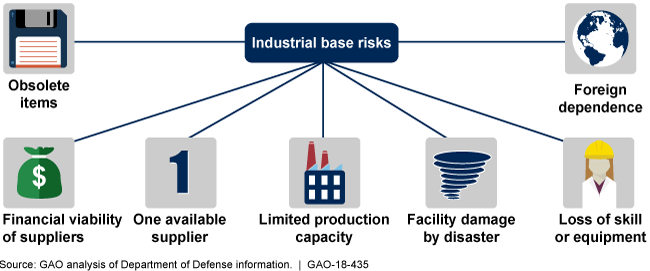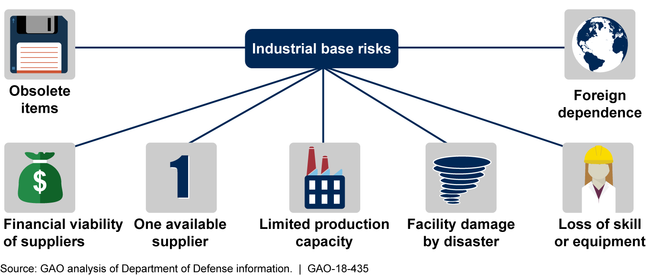Defense Industrial Base: Integrating Existing Supplier Data and Addressing Workforce Challenges Could Improve Risk Analysis
Fast Facts
DOD relies on a network of suppliers (the defense industrial base) to provide the materials and equipment it needs to develop weapon systems.
DOD is required to maintain a data repository of industrial base suppliers to help provide insight about potential risks to the base, such as relying on foreign suppliers. However, DOD hasn't been able to create this repository, partly due to problems it has accessing sensitive supplier data.
DOD is working towards a solution to collect supplier data and analyze industrial base risks. We recommended that DOD resolve ongoing data access problems before further investing in current efforts.
Examples of Risks Facing the Defense Industrial Base

Icons of examples of defense industrial base risks, such as obsolete items, limited production capacity, and foreign dependence.
Highlights
What GAO Found
GAO found that the Department of Defense (DOD) takes a dispersed approach to identify risks to the industrial base that draws on data from several DOD components and acquisition program offices. The figure below highlights examples of industrial base risks that DOD faces.
Examples of Risks Facing the Defense Industrial Base

The Manufacturing and Industrial Base Policy (MIBP) office is DOD's focal point for industrial base issues. MIBP has two data systems that together could meet DOD's requirement for a data repository that centrally identifies available supplier data necessary to conduct industrial base analysis. However, GAO identified certain challenges that have prevented a comprehensive approach to department-wide analysis of risks. For example:
MIBP's data systems do not fully leverage existing data from program offices on the companies that provide parts at the lower tiers of the supply chain, among other things. These data are not currently collected in a standardized format, but would enable MIBP to meet its goal to gain better insights into the supply chain.
MIBP relies on contract staff to augment its workforce; however, MIBP officials have determined that these contractors may not access business-sensitive data needed to build its systems to facilitate industrial base analysis.
MIBP acknowledges these issues, but has not yet determined a solution. Federal Standards for Internal Control call for agency management to utilize quality information and to ensure a personnel mix with the requisite capabilities needed to achieve the agency's objectives. Without addressing these challenges, MIBP is likely spending resources on systems that do not meet its repository requirement or leverage existing data.
To mitigate risks, MIBP administers investment programs that can be used to help sustain or expand the defense manufacturing and industrial base. GAO found that these programs primarily invested in projects to (1) establish economically viable domestic sources of supply, (2) maintain existing suppliers, or (3) develop lower-cost or more efficient manufacturing processes.
Why GAO Did This Study
Each year, DOD spends billions of dollars acquiring and sustaining weapon systems to meet U.S. national security objectives. DOD relies on an extensive, multi-tiered network of suppliers that make up the defense industrial base to provide the components, subsystems, raw materials, and equipment to develop and sustain these weapon systems. Ensuring that these suppliers can provide products and services at the time, quantity, and quality DOD needs is essential to meeting national security objectives. MIBP is DOD's focal point for assessing and mitigating department-wide industrial base risks.
GAO was asked to review DOD's efforts to ensure a viable defense industrial base. This report addresses DOD's approach to identify industrial base risks and its investments to address those risks. GAO reviewed DOD's guidance for industrial base assessments; analyzed industrial base assessments conducted by program offices, military departments and MIBP; reviewed MIBP's efforts to share supplier data; and reviewed documents for all 33 completed investment projects funded by MIBP's investment programs from fiscal years 2014 through 2017.
Recommendations
GAO recommends that DOD make better use of existing supplier data and identify the appropriate workforce mix needed to work with business-sensitive data. DOD partially concurred, but noted that it is taking steps to identify and integrate existing supplier data and is evaluating staff resources for safeguarding business-sensitive data.
Recommendations for Executive Action
| Agency Affected | Recommendation | Status |
|---|---|---|
| Deputy Assistant Secretary of Manufacturing and Industrial Base Policy | As MIBP moves forward with its plans to improve data collection and analysis, the Deputy Assistant Secretary for Defense, Manufacturing and Industrial Base Policy should determine a solution to make better use of existing lower-tier supplier information from program offices. (Recommendation 1) |
In August 2023, the Department of Defense (DOD) provided documentation describing actions it has taken to implement this recommendation. The Office of the Assistant Secretary of Defense for Industrial Base Policy, which absorbed the functions of MIBP, developed a solution to make better use of existing lower-tier supplier information from program offices. Specifically, a data call was issued by the Deputy Secretary of Defense in February 2023, that directed Military Departments, Defense Contract Management Agency, and Defense Logistics Agency to collect and submit data from prime contractors and first and second tier suppliers for weapon systems. The purpose of collecting this information was for DOD to capture industrial base data into a single source, to guide acquisition and sustainment strategies, policies, and mitigation. The Industrial Base Policy office collected data from 110 critical weapon systems and assessed against the industrial base resiliency framework to improve its ability to comprehensively assess supply chain risks across weapon systems, and potentially identify and implement mitigating actions to reduce risks. According to the Industrial Base Policy office, this approach enables them to build a data source for defense industrial base analysis. These efforts came about in response to the requirements by Section 845 of the FY 2020 National Defense Authorization Act and Executive Order 14017 on America's supply chains. In the future, DOD plans to incorporate this data and capabilities into the Advana data system to continue to collect and refine the data, fill information gaps, and assess industrial base risks and associated mitigation strategies for the weapon systems being reviewed.
|
| Deputy Assistant Secretary of Manufacturing and Industrial Base Policy | The Deputy Assistant Secretary for Defense, Manufacturing and Industrial Base Policy should identify the appropriate workforce mix with the requisite skills and capabilities needed to enable MIBP to collect business-sensitive proprietary data to achieve the repository requirement and MIBP's goal of proactive analysis. (Recommendation 2) |
DOD partially concurred with this recommendation, acknowledging the challenges and limitation of using support contractors to handle business-sensitive proprietary data, but noted that any changes to the workforce mix will need to be aligned with DOD's strategic plan. In 2018, DOD's Industrial Policy office, formerly Manufacturing and Industrial Base Policy, assessed its industrial base analysis personnel needs and alignment across industrial sectors. As a result of this assessment, DOD's fiscal year 2020 budget request included a request for 14 additional government full time equivalent positions to support industrial base analytics capabilities. Further, Industrial Policy is leveraging all available avenues to increase the number of Industrial Policy staff that are able to access and analyze proprietary information. For example, Industrial Policy utilized a pilot program established by Section 235 of the National Defense Authorization Act for fiscal year 2017 that allows Federally Funded Research and Development Centers (FFRDCs) to access proprietary information. Industrial Policy also plans to leverage government detailees and internship programs to increase the number of personnel that can access proprietary data for industrial base analysis.
|
